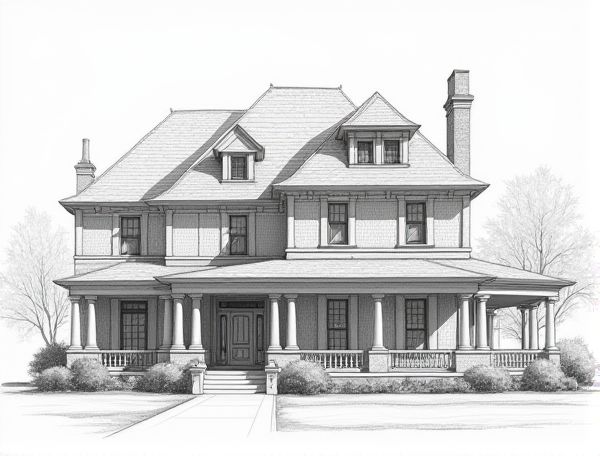
Photo illustration: Colonial revival home design with double-hung sash windows
Colonial Revival home design prominently features double-hung sash windows that enhance the facade's symmetry and classic charm, offering both aesthetic appeal and practical ventilation. Your space can benefit from the timeless elegance and functional advantages of these windows; explore our article to discover how to incorporate them into your home design.
Introduction to Colonial Revival Home Design
Colonial Revival home design captures the timeless elegance of early American architecture, characterized by symmetrical facades, columned porches, and multi-pane windows. Your ideal Colonial Revival home features balanced proportions, decorative shutters, and a central front door framed by pilasters and a pediment. Embracing these classic elements enhances curb appeal and creates a sense of historical charm in your living space.
Historical Roots of Colonial Revival Architecture
Colonial Revival architecture, emerging in the late 19th century, draws inspiration from early American colonial homes, emphasizing symmetry, classical columns, and decorative entryways. Rooted in a nationalistic desire to celebrate America's architectural heritage, this style showcases elements from Georgian and Federal designs, reflecting a blend of practicality and elegance. Your home design can capture the timeless appeal of this movement by incorporating authentic details that honor its historical origins.
Defining Features of Colonial Revival Homes
Colonial Revival homes are characterized by symmetrical facades, accentuated front doors with decorative crown pediments, and multi-pane, double-hung windows often with shutters. These homes typically feature gabled roofs, brick or wood siding, and classical columns supporting porches. Interior layouts emphasize formal living and dining rooms, central hallways, and intricate woodwork reflecting early American colonial architecture.
The Role of Symmetry in Colonial Revival Exteriors
Symmetry in Colonial Revival exteriors creates a balanced, harmonious facade that emphasizes classic architectural elements such as evenly spaced windows, centered doorways, and matching shutters. This design principle enhances curb appeal by evoking a sense of order and timeless elegance, making your home stand out in any neighborhood. Incorporating symmetrical features ensures a cohesive look that honors historical accuracy while promoting visual comfort.
Double-Hung Sash Windows: An Iconic Element
Double-hung sash windows remain an iconic element in home design, known for their classic aesthetic and functional versatility. Featuring two vertically sliding sashes, they provide excellent ventilation control and ease of cleaning. Widely favored in both traditional and modern architectural styles, these windows enhance natural light and contribute to energy efficiency.
Materials and Finishes for Authentic Windows
Choosing high-quality materials like solid wood or premium aluminum enhances the durability and aesthetic appeal of your authentic windows. Finishes such as weather-resistant paints or natural stains protect against environmental damage while accentuating the window's character. You can achieve a timeless look that blends functionality with elegance by selecting finishes tailored to your home's architectural style.
Enhancing Curb Appeal with Double-Hung Sash Windows
Double-hung sash windows significantly enhance your home's curb appeal by combining classic style with modern functionality. Their versatile design allows for superior ventilation and easy cleaning, making your facade both attractive and practical. Choosing energy-efficient double-hung sash windows also boosts your home's value and reduces energy costs.
Energy Efficiency Upgrades for Traditional Windows
Energy efficiency upgrades for traditional windows include installing double-glazed glass, applying low-emissivity (Low-E) coatings, and adding weatherstripping to reduce heat loss. Replacing single-pane windows with insulated frames and using thermal curtains can significantly lower energy consumption and improve indoor comfort. These enhancements contribute to reduced utility bills and increased environmental sustainability in residential buildings.
Interior Design Tips for Colonial Revival Homes
Maximize natural light with strategically placed mirrors and light-colored walls to enhance the airy feel typical of Colonial Revival homes. Incorporate classic elements such as crown moldings, wainscoting, and antique-inspired furnishings to maintain historical authenticity while blending modern comfort.
Preserving and Restoring Vintage Window Details
Preserving and restoring vintage window details enhances your home's character while maintaining energy efficiency through carefully selected materials and techniques. Expert craftsmanship ensures that original features like stained glass, wood frames, and intricate moldings are protected and revitalized to blend seamlessly with modern upgrades.
 homedesy.com
homedesy.com